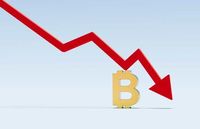Bitcoin (BTC) experienced significant volatility as it slid below the $80,000 mark on April 6, 2025, amid growing fears of a stock market crash fueled by U.S. trade tariffs. The cryptocurrency, which had previously held steady above this threshold, dropped approximately 3% since the start of the week, reflecting broader market turbulence.
Data from Cointelegraph Markets Pro and TradingView indicated that BTC/USD had fallen below $80,000, a stark contrast to the bullish price targets many analysts had been predicting. The downturn coincided with a tumultuous week for U.S. stocks, where both the S&P 500 and Nasdaq Composite Index saw declines nearing 6% during the trading session on April 4.
Financial commentator Holger Zchaepitz highlighted the severity of the situation, stating, "Trump's tariff announcement this week has wiped out $8.2 trillion in stock market value — more than was lost during the worst week of the 2008 financial crisis." This alarming statistic underscored the potential for a significant economic downturn, leading to speculation about a possible repeat of the infamous stock market crash of 1987.
Jim Cramer, host of CNBC’s “Mad Money,” expressed concerns over the current market dynamics, suggesting that the conditions could lead to another catastrophic event similar to the October 1987 crash. He remarked, "It's tough to build a new, weaker, world order on the fly... I don't see anything yet that takes the October '87 scenario off the table." Cramer’s warnings resonated with many investors, who were on high alert for further market declines.
Despite the bearish atmosphere surrounding traditional markets, some Bitcoin enthusiasts remained optimistic. Max Keiser, a well-known Bitcoin advocate, boldly predicted that BTC could soar to $220,000 by the end of April, stating, "A 1987 style mega crash will push Bitcoin to $220,000 this month as trillions in wealth seek the ultimate safe haven: Bitcoin." This assertion reflects a growing sentiment among some traders that Bitcoin may serve as a refuge during times of economic uncertainty.
In the trading community, opinions on Bitcoin's future were mixed. Trader Daan Crypto Trades noted that while Bitcoin's volatility was decreasing, the Volatility Index (VIX) for stocks had reached its highest level since the COVID-19 market crash in 2020. He suggested that this compression in volatility could lead to a significant movement for crypto in the coming week, contingent on whether stocks find a bottom early in the week.
Meanwhile, fellow trader Cas Abbe pointed to the recent lows of $76,000 on BTC/USD, suggesting that this might represent a classic fake breakdown. He stated, "This looks no different than the post-ETF dump and August 2024 crash. I'm waiting for a weekly reclaim of $92,000 to confirm the uptrend." This highlights the cautious optimism among some traders who believe Bitcoin could rebound.
As the new week opened, social media buzzed with discussions about Bitcoin's performance relative to traditional assets. Despite its recent losses, Bitcoin demonstrated relative resilience around the $80,000 level compared to the broader market turmoil. Analysts noted that while BTC had lost ground, its decline was not as severe as the stock market's downturn.
On April 7, 2025, Bitcoin traded at approximately $79,000, down around 3% for the week, yet still showing signs of resilience amidst the chaos triggered by Trump's tariff policies. The tariffs, which officially took effect on April 5, were expected to have far-reaching implications for the economy, with investor sentiment growing increasingly cautious.
Additionally, the cryptocurrency market faced challenges beyond Bitcoin. XRP, another major cryptocurrency, was under pressure, facing a potential 25% decline as bearish technical patterns emerged amid ongoing whale distribution activity. XRP had already dropped more than 35% from its January high of $3.40, trading around $1.93 as of early April.
In the midst of these developments, Solana (SOL) continued to show robust growth despite experiencing a 9% price drop, trading around $107. The network's total value locked had peaked in June 2022, highlighting its ongoing strength in the DeFi ecosystem.
As the market navigates this turbulent period, many analysts are urging caution. The uncertainty surrounding Trump's tariff policies has left investors wary, with Bitcoin and other cryptocurrencies often viewed as high-risk assets that do not thrive in unstable economic conditions. The broader sentiment among traders is one of vigilance, as they prepare for potential market fluctuations in the days ahead.
In summary, Bitcoin's recent volatility reflects the broader economic concerns tied to U.S. trade policies and market dynamics. While some traders remain hopeful for a rebound, the overall landscape is fraught with uncertainty, prompting many to reassess their investment strategies as they brace for potential further declines.







